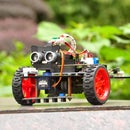Introduction: NodeMCU MQTT Iot Project - Switch Button
OSOYOO NodeMCU IOT Starter kit
Please follow us on facebook, find our new released item and share your idea and Video on how to creatively use our products. You can get cash back or giveaway from us!
Facebook: https://www.facebook.com/pg/OsoyooProducts
Youtube: https://www.youtube.com/channel/UCZsnf-n1TR1MGQT-...
In this lesson, we will connect a switch button to the NodeMCU ,and send the switch status to a MQTT broker. When the button is pressed, NodeMCU will publish the button status “pressed” to MQTT broker and the MQTT client will subscribe to these messages. When the push button is released, “not pressed” will be sent.
Step 1: Preparation
Hardware:
NodeMCU board x 1
Switch Button x 1
1K resistor x 1
Breadboard x 1
Jumper wires
Software:
Arduino IDE(version 1.6.4+)
ESP8266 Board Package and the Serial Port Driver
MQTT Client (MQTTBox here)
Arduino library: PubSubClient
Step 2: Connection Graph
In this lesson,we use D2(GPIO4) to control the switch,please setup the hardware according the connection graph.
Note: the 1k resistor is using as a pull down resistor, In such a circuit, when the switch is closed, the NodeMCU input is at a logical high value, but when the switch is open, the pull-down resistor pulls the input voltage down to ground (logical zero value), preventing an undefined state at the input.
Step 3: Code
Copy the below code to Arduino IDE:
/* ___ ___ ___ _ _ ___ ___ ____ ___ ____
* / _ \ /___)/ _ \| | | |/ _ \ / _ \ / ___) _ \| \ *| |_| |___ | |_| | |_| | |_| | |_| ( (__| |_| | | | | * \___/(___/ \___/ \__ |\___/ \___(_)____)___/|_|_|_| * (____/ * Use the NodeMCU send switch button status to MQTT client via WiFi * Tutorial URL: * CopyRight www.osoyoo.com */ #include #includeint BUTTON_PIN = D2; //button is connected to GPIO pin D1 // Update these with values suitable for your network. const char* ssid = "********";//put your wifi ssid here const char* password = "********";//put your wifi password here. const char* mqtt_server = "broker.mqttdashboard.com"; //const char* mqtt_server = "iot.eclipse.org";
WiFiClient espClient; PubSubClient client(espClient); long lastMsg = 0; char msg[50];
void setup_wifi() { delay(100); // We start by connecting to a WiFi network Serial.print("Connecting to "); Serial.println(ssid); WiFi.begin(ssid, password); while (WiFi.status() != WL_CONNECTED) { delay(500); Serial.print("."); } randomSeed(micros()); Serial.println(""); Serial.println("WiFi connected"); Serial.println("IP address: "); Serial.println(WiFi.localIP()); }
void callback(char* topic, byte* payload, unsigned int length) { } //end callback
void reconnect() { // Loop until we're reconnected while (!client.connected()) { Serial.print("Attempting MQTT connection..."); // Create a random client ID String clientId = "ESP8266Client-"; clientId += String(random(0xffff), HEX); // Attempt to connect //if you MQTT broker has clientID,username and password //please change following line to if (client.connect(clientId,userName,passWord)) if (client.connect(clientId.c_str())) { Serial.println("connected"); //once connected to MQTT broker, subscribe command if any client.subscribe("OsoyooCommand"); } else { Serial.print("failed, rc="); Serial.print(client.state()); Serial.println(" try again in 5 seconds"); // Wait 5 seconds before retrying delay(5000); } } } //end reconnect()
void setup() { Serial.begin(115200); setup_wifi(); client.setServer(mqtt_server, 1883); client.setCallback(callback); pinMode(BUTTON_PIN,INPUT); }
void loop() { if (!client.connected()) { reconnect(); } client.loop(); long now = millis(); int status; //send message every 2 second if (now - lastMsg > 2000) { lastMsg = now; status=digitalRead(BUTTON_PIN); String msg="Button status: "; if(status==HIGH ) { msg= msg+ "Pressed"; char message[58]; msg.toCharArray(message,58); Serial.println(message); //publish sensor data to MQTT broker client.publish("OsoyooData", message); } else { msg= msg+ " Not Press"; char message[58]; msg.toCharArray(message,58); Serial.println(message); //publish sensor data to MQTT broker client.publish("OsoyooData", message); } } }
Edit the code to fit your own WiFi and MQTT settings as following operations:
1)Hotspot Configration:Find below code line,put your own ssid and password on there.
const char* ssid = “your_hotspot_ssid”;
const char* password = “your_hotspot_password”;
2)MQTT Server Address Setting: You can use your own MQTT broker URL or IP address to set above mqtt_server value. You can also use some famous free MQTT server to test the project such as “broker.mqtt-dashboard.com”, “iot.eclipse.org” etc.
const char* mqtt_server = “broker.mqtt-dashboard.com”;
3)MQTT Client Settings
If your MQTT broker require clientID,username and password authentication,you need to change
if (client.connect(clientId.c_str()))
To
if (client.connect(clientId,userName,passWord)) //put your clientId/userName/passWord here
If not,just keep them as default.
After do that,choose the coresponding board type and port type as below,then upload the sketch to the NodeMCU.
- Board:”NodeMCU 0.9(ESP-12 Module)”
- CPU Frequency:”80MHz”Flash Size:”
- 4M (3M SPIFFS)”
- Upload Speed:”115200″
- Port: Choose your own Serial Port for your NodeMCU
Step 4: MQTT Client Settings
If you don't know how to config MQTT client, please visit our last article: https://www.instructables.com/id/NodeMCU-MQTT-Basi...
Topics Settings:
Topic to publish: OsoyooCommand
Topic to subscribe: OsoyooData
Running Result
Once the upload done,if wifi hotspot name and password setting is ok and MQTT broker is connected, open the Serial Monitor,you will see following result:Keep pressing this button,the Serial Monitor will output “Button status: Pressed” every 2 second;once release this button,the Serial Monitor will output “Button status: Not Pressed” every 2 second.











